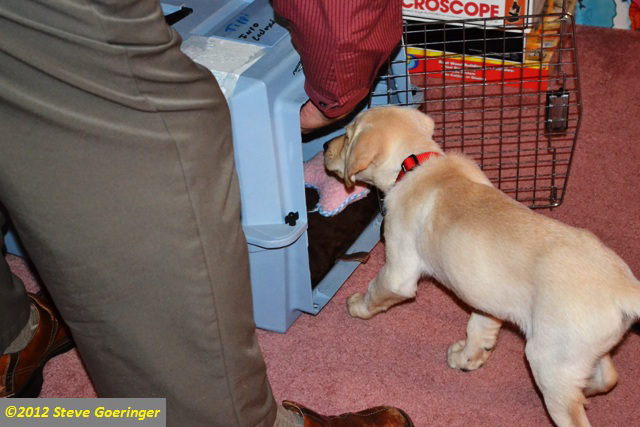One of the fastest ways to potty train your puppy is to crate train them. Dogs are den animals and prefer to be underneath other things for protection and shelter. A crate can serve as their den.

Check out some answers to some common crate training questions:
What is crate training? Like babies, puppies cannot control their bladders until they mature (usually between 3 and 6 months). Lucky us, dogs have a natural instinct to avoid eliminating in their dens. Therefore, confining your puppy in his crate for the proper amount of time encourages him to “hold it” until you take him outside for a walk. Here is a FREE step by step guide on housebreaking and crate training puppies (including the rules of crate training and additional crate training tips).
How long do I need to use the crate? Crates are not just for training, they are good for all life stages! By providing a crate for your dog, you are in essence providing him with his own bedroom. Crates are especially important for older dogs that use it to escape the hustle and bustle of everyday family life, which often includes small children or other pets that may harass them.
How safe is crate training? Dog crates are the best housetraining tool available. They provide a room for your dog while protecting your home furnishings from damage. However, even a crate isn’t an absolute safe harbor for your pet. As per crate manufacturers warnings, you should always remove standard collars before placing your dog in a crate. The only collar we recommend as being safe when inside a crate is Premier’s “KeepSafe” break-away collar. Otherwise, your dog is at risk for possible strangulation if his collar or ID tags become caught in the crate’s bars. Cratewear bumpers are the only bumpers made high enough to help prevent collar strangulation and other crate-related injuries.
Did you know: If your dog wears a collar in his crate, he is at risk for possible strangulation!
I was told that dogs like their crates, so why do I have to force mine inside?
There are many reasons to not enjoy a bare metal dog cage:
Comfort: when dogs lie down in their crates, they are leaning up against wire bars, which can be very irritating. Cratewear’s quilted bumpers provide the comfort they need while also protecting their coats, wagging tails, noses and teeth from the metal. What’s more, itss reversible and machine washable crate pads add comfort he’ll appreciate.
Security: wire crates leave your dog exposed on all sides. Crate covers provide den like security.
Location: separating your dog from the rest of the family can add stress to your dog. Dogs are social animals, so the ideal location is a room full of activity. Your dog will enjoy his new room while still being part of the family. At night the bedroom is an ideal place for a crate so your dog will feel the security of being close to you.
Time: confining him in his crate for excessive periods of time will be a negative experience for your dog. After housebreaking your dog, we recommend removing the door from the crate so he can enjoy his den any time he chooses.
Did you know: Top veterinarians and dog trainers recommend covering your dog crate
Some things you can do to make dog crates and kennels more appealing:
- Use Cratewear to make his crate safe & comfortable
- Put appropriate toys and treats inside the crate, which will entice him to go in on his own.
- Feeding your dog in his crate can develop a positive association with it.
- Give your puppy lots of praise when he enters the crate.
How do I stop my dog from whining or barking the crate?
Again, make sure the crate is in a good location. Veterinarians and trainers recommend covering the crate to give your dog the privacy he needs to feel secure. If your dog can see you, he’ll want to be with you outside the crate. Crate covers lower the number of distractions your dog sees, which reduces barking and stress. Note: Dogs that suffer from separation anxiety should not be crated. If you feel your dog is suffering from separation anxiety and is showing clinical signs, please avoid crating him until speaking to a professional.
Just make sure to watch for any wear and tear on the dogs nails, teeth and bodies to make sure the crate is not causing them any harm. If you notice any harm being cause immediately stop using a crate and consult a vet for further instruction. You may just need to dress the crate up a little or get the right size, but it is always better to be safe than sorry.
Do you crate train? Why or why not?




Leave a Reply